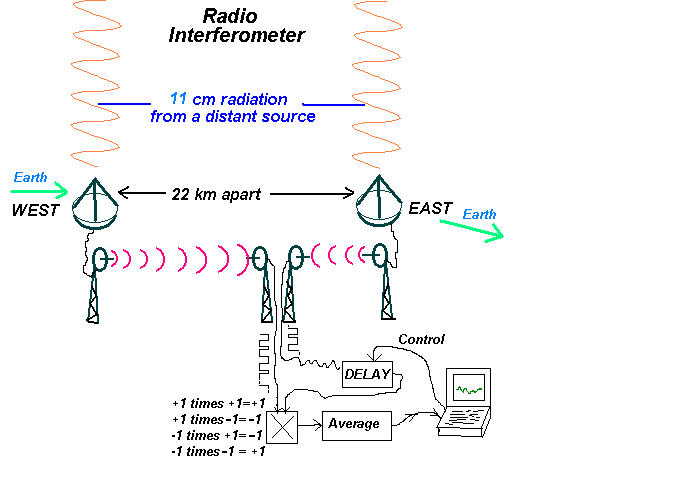
If only noise is entering the antennas, these four possibilities will be equally likely and each will happen one quarter of the time. If we multiply the bits together and average the result, the average will go to zero.
1. The bits are the same and are both +1,
2. they're the same and both -1,
3. West is -1 and East is +1,
4. or East is -1 and West is +1.

In the very unlikely event we receive a signal from ETI (Extra Terrestrial Intelligence),
we will spot a positive number or a negative number in our data. Sort of like the -20
that popped out of the data shown below, but THIS IS NOT FROM ETI!!!. Well, I really don't
know where it came from. My guess it is noise, but it could have been a glitch in the radio links.
I SAY IT IS NOT FROM ETI.
The spacing in time between lines in the tables is about 1.6 seconds. We use the Julian Date
because it keeps track of time and date with one number. The number changes by one every day.
Julian Date the seven delays a number indicating how far off the PC clock is from the Earth's standard atomic clocks 2451405.68811 -6 -2 -6 -5 -3 -3 -1 -9 2451405.68813 -10 -5 -2 0 7 -7 -9 -9 2451405.68815 -2 -8 -2 -6 0 -1 -3 -9 2451405.68817 0 -2 -6 3 -13 1 7 -9 2451405.68819 -2 -2 -3 -3 -2 -9 -5 -9 2451405.68821 0 -1 -3 0 -12 4 -4 -9 2451405.68823 0 0 -1 -5 -5 0 -8 -9 2451405.68825 4 -4 0 -5 -8 -7 -1 -9 2451405.68826 -4 4 -4 0 -11 0 -1 -9 2451405.68828 -5 3 -6 -1 -7 -4 -8 -9 2451405.68830 -5 -9 -1 -4 -4 -11 8 -9 2451405.68832 0 0 -4 -3 -6 -7 -5 -9 2451405.68834 -11 -1 -6 0 -20 -6 -7 -9 <<<<<<<< THIS IS _NOT_ ETI !!!! 2451405.68836 -3 0 -1 0 -1 -1 -9 -9 2451405.68838 3 0 0 0 0 -4 -4 -9 2451405.68840 -6 0 -8 -2 5 -2 0 -9 2451405.68842 2 -8 -4 -9 -5 0 0 -9 2451405.68844 -4 -5 3 -6 -13 2 -2 -9 2451405.68845 3 -5 -7 -12 0 -12 5 -9 2451405.68847 -2 -1 0 4 -1 -4 -4 -9 2451405.68849 -6 -4 -6 2 1 0 -1 -9 2451405.68851 1 -1 -1 6 4 0 0 -9 2451405.68853 5 7 -3 0 2 -5 -2 -9 2451405.68855 4 -3 0 -11 -1 1 1 -9 2451405.68857 -2 0 -8 6 -3 -3 -2 -9 2451405.68859 -1 -3 -3 -2 -5 -5 -2 -9 2451405.68861 0 0 2 -1 -1 -5 -4 -9
An object in the sky, such as a black hole, might look like this:
2451405.68891 -2 0 -1 3 -6 0 0 -9 2451405.68893 1 -6 -2 0 -3 -8 -6 -9 2451405.68895 -6 3 4 -2 -2 2 -6 -9 2451405.68897 5 -2 -4 0 1 -10 -7 -9 2451405.68898 1 -1 -2 -4 3 -3 -5 -9 2451405.68900 -1 0 1 4 0 3 1 -9 2451405.68902 0 -5 -3 3 -1 1 -3 -9 2451405.68904 3 -8 -7 -1 6 -4 -5 -9 2451405.68906 -1 0 0 0 0 -4 -6 -9 2451405.68908 -1 0 1 0 0 -1 -6 -9 2451405.68910 4 1 -1 7 -7 -8 -3 -9 < Note that the fifth data column 2451405.68912 6 -7 2 -3 -1 -6 -1 -9 < numbers are mostly 2451405.68914 5 -3 -1 0 -4 -3 -4 -9 < negative (around here). This may 2451405.68915 -5 4 -2 0 -8 -3 -2 -9 < be from something in the sky, 2451405.68917 -2 -13 0 -9 -5 -6 -2 -9 < or maybe due to some drift 2451405.68919 -7 -3 -7 -7 -4 4 -3 -9 < in the receiver. The receiver 2451405.68921 0 -5 1 -4 -1 -7 1 -9 < is being improved, and more 2451405.68923 -1 -4 -1 -6 1 3 -9 -9 < data is being taken. 2451405.68925 -4 0 -5 4 -6 -10 -2 -9 < By looking at the same point 2451405.68927 0 -6 -2 -1 -8 -3 0 -9 < in the sky two days in a row, 2451405.68929 -2 0 -1 7 -1 -2 -3 -9 < and compensating (about 4 min. per day) 2451405.68931 0 -7 0 -3 -3 1 -10 -9 < for the Earth's orbit around the Sun, 2451405.68933 -2 -3 -1 0 -1 1 0 -9 < we see this plot . 2451405.68934 0 -10 0 1 2 0 -6 -9 (It's not at the same time as this 2451405.68936 -6 3 0 -4 0 0 0 -9 tabular data. Note the interesting 2451405.68938 2 2 -3 1 0 2 -3 -9 daily repetition in the plot.) 2451405.68940 -1 0 -3 3 0 -4 0 -9 2451405.68942 -3 0 -1 -3 0 -6 4 -9 2451405.68944 0 -2 -3 -1 1 0 0 -9